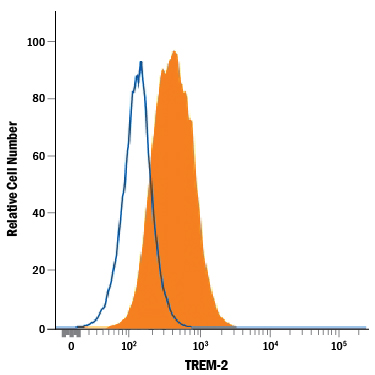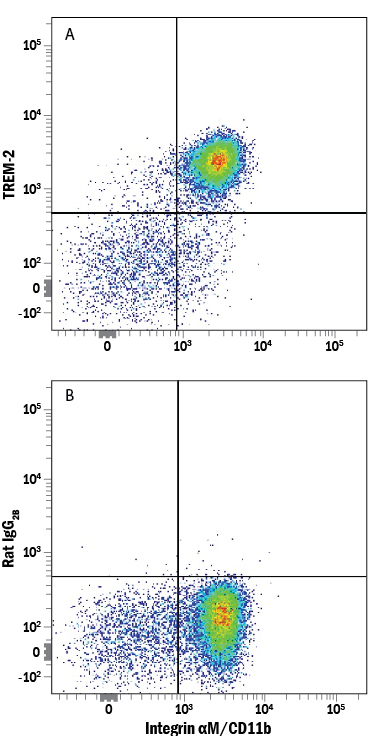Human/Mouse TREM2 Alexa Fluor® 594-conjugated Antibody Summary
extracellular domain
Accession # Q99NH8
Applications
Please Note: Optimal dilutions should be determined by each laboratory for each application. General Protocols are available in the Technical Information section on our website.
Scientific Data
 View Larger
View Larger
Detection of TREM‑2 in RAW 264.7 Mouse Cell Line by Flow Cytometry. RAW 264.7 mouse monocyte/macrophage cell line was stained with Rat Anti-Human/Mouse TREM-2 Alexa Fluor® 594-conjugated Monoclonal Antibody (Catalog # FAB17291T, filled histogram) or isotype control antibody (Catalog # IC013T, open histogram). View our protocol for Staining Membrane-associated Proteins.
 View Larger
View Larger
Detection of TREM‑2 in Human PBMCs by Flow Cytometry. Human peripheral blood mononuclear cells (PBMCs) were stained with Mouse Anti-Human Integrin aM/CD11b APC-conjugated Monoclonal Antibody (Catalog # FAB16991A) and either (A) Rat Anti-Human/Mouse TREM-2 Alexa Fluor® 594-conjugated Monoclonal Antibody (Catalog # FAB17291T) or (B) Rat IgG2BAlexa Fluor 594 Isotype Control (Catalog # IC013T). View our protocol for Staining Membrane-associated Proteins.
Reconstitution Calculator
Preparation and Storage
- 12 months from date of receipt, 2 to 8 °C as supplied.
Background: TREM2
TREM-2 (Triggering Receptor Expressed on Myeloid cells-2) is a 35 kDa molecular weight type I transmembrane member of the TREM family and Ig superfamily. Mature human TREM-2 consists of a 156 amino acid (aa) extracellular domain (ECD) with one V-type Ig-like domain, a 21 aa transmembrane (TM) domain, and a 35 aa cytoplasmic tail. Within the ECD, human TREM-2 shares 73% and 74% aa sequence identity with mouse and rat TREM-2, respectively. Two closely related transcripts were reported in mouse and designated TREM-2a and TREM-2b. Soluble forms of the TREM-2 ECD are generated by alternative splicing or proteolytic cleavage, and the cytoplasmic domain can be liberated by gamma-Secretase mediated intramembrane cleavage. It is a pattern recognition receptor that binds anionic ligands. A positively charged lysine within the transmembrane segment allows association with the signal adapter protein, DAP12 to deliver an activating signal that plays a role in both innate and adaptive immune responses, including inhibition of macrophage activation. TREM-2 is expressed on macrophages, immature myeloid dendritic cells, osteoclasts, microglia, and adipocytes. It promotes the differentiation and function of osteoclasts, the production of inflammatory cytokines by adipocytes, insulin resistance, and the phagocytic clearance of bacteria. In the CNS, TREM-2 binds to ApoE, ApoA1, and ApoB and mediates the clearance of apoptotic neurons, amyloid plaques, and cell debris following demyelination. TREM-2 also interacts with and modifies signaling through Plexin A1 on dendritic cells and osteoclasts. Mutations in TREM-2 or DAP12 are associated with the development of Alzheimer's disease and Nasu-Hakola disease (NHD/PLOSL) which is characterized by presenile dementia and bone cysts. Soluble TREM-2 is elevated in cerebrospinal fluid of patients with active multiple sclerosis (MS), and TREM-2 blockade exacerbates disease symptoms in the experimental EAE model of MS.
Product Datasheets
Product Specific Notices
This product is provided under an agreement between Life Technologies Corporation and R&D Systems, Inc, and the manufacture, use, sale or import of this product is subject to one or more US patents and corresponding non-US equivalents, owned by Life Technologies Corporation and its affiliates. The purchase of this product conveys to the buyer the non-transferable right to use the purchased amount of the product and components of the product only in research conducted by the buyer (whether the buyer is an academic or for-profit entity). The sale of this product is expressly conditioned on the buyer not using the product or its components (1) in manufacturing; (2) to provide a service, information, or data to an unaffiliated third party for payment; (3) for therapeutic, diagnostic or prophylactic purposes; (4) to resell, sell, or otherwise transfer this product or its components to any third party, or for any other commercial purpose. Life Technologies Corporation will not assert a claim against the buyer of the infringement of the above patents based on the manufacture, use or sale of a commercial product developed in research by the buyer in which this product or its components was employed, provided that neither this product nor any of its components was used in the manufacture of such product. For information on purchasing a license to this product for purposes other than research, contact Life Technologies Corporation, Cell Analysis Business Unit, Business Development, 29851 Willow Creek Road, Eugene, OR 97402, Tel: (541) 465-8300. Fax: (541) 335-0354.
FAQs
-
What type of light chain does the Human/Mouse TREM-2 Antibody, Cat# MAB17291, clone # 237920 have?
This antibody has a kappa light chain.
Reviews for Human/Mouse TREM2 Alexa Fluor® 594-conjugated Antibody
There are currently no reviews for this product. Be the first to review Human/Mouse TREM2 Alexa Fluor® 594-conjugated Antibody and earn rewards!
Have you used Human/Mouse TREM2 Alexa Fluor® 594-conjugated Antibody?
Submit a review and receive an Amazon gift card.
$25/€18/£15/$25CAN/¥75 Yuan/¥2500 Yen for a review with an image
$10/€7/£6/$10 CAD/¥70 Yuan/¥1110 Yen for a review without an image

